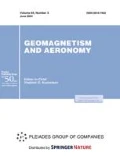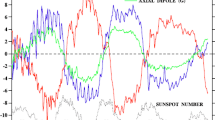Abstract
The solar polar magnetic field has attracted the attention of researchers since the polar magnetic field reversal was revealed in the middle of the last century (Babcock and Livingston, 1958). The polar magnetic field has regularly reversed because the magnetic flux is transported from the sunspot formation zone owing to differential rotation, meridional circulation, and turbulent diffusion. However, modeling of these processes leads to ambiguous conclusions, as a result of which it is sometimes unclear whether a transport model is actual. Thus, according to the last Hinode data, the problem of a standard transport model (Shiota et al., 2012) consists in that a decrease in the polar magnetic flux in the Southern Hemisphere lags behind such a decrease in the flux in the Northern Hemisphere (from 2008 to June 2012). On the other hand, Svalgaard and Kamide (2012) consider that the asymmetry in the sign reversal simply results from the asymmetry in the emerging flux in the sunspot formation region. A detailed study of the polar magnetic flux evolution according to the Solar Dynamics Observatory (SDO) data for May 2010–December 2012 is illustrated in the present work. Helioseismic & Magnetic Imager (HMI) magnetic data in the form of a magnetic field component along the line of sight (the time resolution is 720 s) are used here. The magnetic fluxes in sunspot formation regions and at high latitudes have been compared.
Similar content being viewed by others
References
Babcock, H.W. and Livingston, W.C., Changes in the Sun’s polar magnetic field, Science, 1958, vol. 127, p. 1058.
Babcock, H.D., The Sun’s polar magnetic field, Astrophys. J. Lett., 1959, vol. 130, pp. 364–365.
Benevolenskaya, E.E., Impulses of activity and the Solar cycle, Sol. Phys., 2003, vol. 216, pp. 325–341.
Benevolenskaya, E.E., Polar magnetic flux on the Sun in 1996–2003 from SOHO/MDI data, Astron. Astrophys., 2004, vol. 428, pp. L5–L8.
Benevolenskaya, E.E., Astron. Nachr., 2010, vol. 331, pp. 63–72.
Dikpati, M., Polar field puzzle: Solutions from flux-transport dynamo and surface-transport models, Astrophys. J. Lett., 2011, vol. 733, no. 2, p. 90.
Jiang, J., Cameron, R.H., Schmitt, D., and Schüssler, M., Can surface flux transport account for the weak polar field in cycle 23?, Space Sci. Rev., 2011.
Leighton, R.B., Transport of magnetic fields on the Sun, Astrophys. J. Lett., 1964, vol. 140, pp. 1547–1562.
Leighton, R.B., A magneto-kinematic model of the solar cycle, Astrophys. J. Lett., 1969, vol. 156, pp. 1–26.
Lin, H., Varsik, J., and Zirin, H., High-resolution observations of the polar magnetic fields of the Sun, Sol. Phys., 1994, vol. 155, pp. 243–256.
Livshits, I.M. and Obridko, V.N., Variations of the dipole magnetic moment of the Sun during the solar activity cycle, Astron. Rep., 2006, vol. 50, no. 11, pp. 926–935.
Okunev, O.V. and Kneer, F., On the structure of polar faculae on the Sun, Astron. Astrophys., 2004, vol. 425, pp. 321–331.
Pesnell W.D., Thompson, B.J., and Chamberlin, P.C., The Solar Dynamics Observatory (SDO), Sol. Phys., 2012, vol. 275, pp. 3–15.
Pucci, S., Poletto, G., Sterling, A.C., and Romoli, M., Solar polar X-ray jets and multiple bright points: Evidence for sympathetic activity, Astrophys. J. Lett., vol. 745, no. 2, p. L31.
Savcheva, A. and Cirtain, J.E., Deluca, E.E., Lundquis, L.L., Golub, L., Weber, M., Shimojo, M. Shibasaki, K., Sakao, T., and Narukage, N., Study of polar jet parameters based on Hinode XRT observations, Obs. Publ. Astron. Soc. Japan, 2007, vol. 59, pp. S771–S778.
Scherrer, P.H., Schou, J., Bush, R.I., Kosovichev, A.G., Bogard, R.S., Hoeksema, J.T., Liu, Y., Duvall, Jr.T.L., Zhao, J., Title, A.M., Schrijver, C.J., Tarbell, T.D., and Tomczyk, S., The Helioseismic and 7 Magnetic Imager (HMI) Investigation for the Solar Dynamics Observatory (SDO) Sol. Phys., 2012, vol. 275, pp. 207–227.
Severnyi, A.B., The nature of solar magnetic fields (The fine structure of the field), Sov. Astron. Lett., 1965, no. 9, pp. 171–182.
Shiota, D., Tsuneta, S., Shimojo, M., Sako, N., Orozco Suarez, D., and Ishikawa, R., Polar field reversal observations with hinode, Astrophys. J. Lett., 2012, vol. 753, p. 157.
Svalgaard, L. Cliver, E.W., and Kamide, Y., Sunspot cycle 24: Smallest cycle in 100 years? ASP Conf. Ser., 2005, vol. 346, p. 401.
Svalgaard, L. and Kamide, Y., Asymmetric solar polar field reversals, Astrophys. J. Lett., 2012, vol. 763, p. 6.
Author information
Authors and Affiliations
Rights and permissions
About this article
Cite this article
Benevolenskaya, E.E. Solar polar magnetic field. Geomagn. Aeron. 53, 891–895 (2013). https://doi.org/10.1134/S0016793213070037
Received:
Published:
Issue Date:
DOI: https://doi.org/10.1134/S0016793213070037




